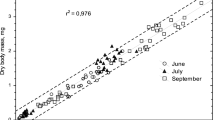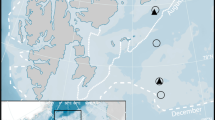Abstract
The benthic amphipod Ampelisca abdita dominates mudbottom benthic communities in Jamaica Bay (New York). In this study, we investigated the trophic role of Ampelisca in relation to winter flounder (Pleuronectes americanus) populations—the most frequently trawled fish species in Jamaica Bay. Flounders collected by trawl during summer 1989 were primarily juveniles. Stomach analyses indicated that amphipod crustaceans contributed >99% of prey individuals, with A. abdita making up 88%. Density and size frequency analyses of Ampelisca at three sites indicated two overlapping cohorts: a spring cohort released in June and a summer cohort released in late summer. Most overwintering survivors come from the summer cohort. Secondary production of Ampelisca was estimated at three sites using the cohort summation of biomass method. Estimates of annual production ranged from 25 g DW to 47 g DW m−2 (mortality + residual biomass); production due to growth ranged from 20 g DW to 26 g DW. Simulations of spring cohort production using a range of plausible growth and mortality schedules suggested that P∶B may be more sensitive to variability in survivorship than growth. Ampelisca secondary production in Jamaica Bay is compared with other amphipod species and with macrobenthic production in other coastal and estuarine systems. We conclude that observed amphipod production is probably more than sufficient to support local winter flounder populations in Jamaica Bay, and we speculate that high nutrient loadings may indirectly stimulate amphipod production. *** DIRECT SUPPORT *** A01BY058 00010
Similar content being viewed by others
Literature Cited
Bascom, W., A. J. Mearns, and J. Q. Word. 1979. Establishing boundaries between normal, changed and degraded areas, p. 81–94. In Annual Report of the Southern California Coastal Water Research Project, El Segundo, California.
Berg, D. L. and J. S. Levinton. 1985. The biology of the Hudson-Raritan Estuary, with emphasis on fishes. NOAA Technical Memorandum National Ocean Service. Rockville, Maryland. 170 p.
Birklund, J. 1977. Biomass, growth and production of the amphipod Corophium insidiosum Crawford, and preliminary notes on Corophium volutator (Pallas). Ophelia 16:187–203.
Carrasco, F. D. and D. F. Arcos. 1984. Life history and production of a cold-temperate population of the sublittoral amphipod Ampelisca araucana. Marine Ecology Progress Series 14:245–252.
Collie, J. S. 1985. Life history and production of three amphipod species on Georges Bank. Marine Ecology Progress Series 22:229–238.
Croker, R. A. 1965. Planktonic fish eggs and larvae of Sandy Hook Estuary. Chesapeake Science 6:92–95.
Crisp, D. J. 1971. Energy flow measurements, p. 197–279. In N. A. Holme and A. D. McIntyre (eds.), Methods for the Study of Marine Benthos. IBP Handbook 16, Blackwell Publ., Oxford, United Kingdom.
Dauer, D. M. and W. G. Conner. 1980. Effects of moderate sewage input on benthic polychaete populations. Estuarine Coastal Marine Science 16:335–346.
Dauvin, J. C. 1984. Dynamique d’ecosystemes macrobenthiques des fonds sedimentaires de la baie de Morlaix et leur perturbation par les hydrocarbures de l’Amoco Cadiz. Ph.D. Dissertation, Universite Pierre et Marie Curie, Paris, France.
Dauvin, J. C. 1988a. Biologie, dynamique et production des populations de Crustaces Amphipodes de la Manche Occidentale. 1. Ampelisca tenuicornis Liljeborg. Journal of Experimental Marine Biology and Ecology 118:55–84.
Dauvin, J. C. 1988b. Biologie, dynamique et production des populations de Crustaces Amphipodes de la Manche Occidentale. 2. Ampelisca brevicornis (Costa). Journal of Experimental Marine Biology and Ecology 119:213–233.
Dauvin, J. C. 1988c. Biologie, dynamique et production des populations de Crustaces Amphipodes de la Manche Occidentale. 3. Ampelisca typica (Bate). Journal of Experimental Marine Biology and Ecology 121:1–22.
Dauvin, J. C. 1988d. Life cycle, dynamics and productivity of Crustacea-Amphipoda from the western part of the English channel. 4. Ampelisca armoricana Bellan-Santini & Dauvin. Journal of Experimental Marine Biology and Ecology 123:235–252.
Dauvin, J. C. 1989. Life cycle, dynamics and productivity of Crustacea-Amphipoda from the western English Channel. 5. Ampelisca sarsi (Chevreux). Journal of Experimental Marine Biology and Ecology 128:31–56.
Dauvin, J. C. and M. Joncourt. 1989. Energy values of marine benthic invertebrates from the western English Channel. Journal of the Marine Biological Association, United Kingdom 69: 589–595.
Diaz, R. J. and L. C. Schaffner. 1990. The functional role of estuarine benthos, p. 25–56. In M. Haire and E. C. Krome (eds.), Perspectives on the Chesapeake Bay, 1990. U.S. Environmental Protection Agency Chesapeake Program, CBP/ TRS41/90.
Franz, D. R. and W. H. Harris. 1985. Benthos Study, Jamaica Bay Wildlife Refuge, Gateway National Recreation Area, New York. Final Report, U.S. Department of Interior. Contr. CX1600-1-0031. 109 p.
Franz, D. R. and W. H. Harris. 1988. Seasonal and spatial variability in macrobenthos communities in Jamaica Bay, New York—An urban estuary. Estuaries 11:15–28.
Fredette, T. J. and R. J. Diaz. 1986. Secondary production of Gammarus mucronatus Say (Amphipoda: Gammaridae) in warm temperate estuarine habitats, York River, Virginia. Journal of Crustacean Biology 6:729–741.
Grassle, J. F. and J. P. Grassle. 1974. Opportunistic life histories and genetic systems in marine benthic polychaetes. Journal of Marine Research 32:253–284.
Gray, J. S. 1989. Effects of environmental stress on species-rich assemblages, p. 19–32. In P. Calow and R. J. Berry (eds.), Evolution, Ecology, and Environmental Stress. Academic Press, San Diego, California.
Hacunda, J. S. 1981. Trophic relationships among demersal fishes in a coastal area of the Gulf of Maine. Fishery Bulletin 79:775–788.
Howe, S. and W. Leathem. 1984. Secondary production of benthic macrofauna at three stations of Delaware Bay and coastal Delaware. NOAA Technical Memoirs NMFS-F/NEC 32. 62 p.
LaFrance, K. and E. Ruber. 1985. The life cycle and productivity of the amphipod Gammarus mucronatus on a northern Massachusetts salt marsh. Limnology and Oceanography 30: 1067–1077.
Levin, L. A. 1986. Effects of enrichment on reproduction in the opportunistic polychaete Streblospio benedicli (Webster): A mesocosm study. Biological Bulletin 171:143–160.
MacDonald, P. D. M. 1987. Analysis of length-frequency distributions, p. 371–384. In R. C. Summerfelt and G. E. Hall (eds.), Age and Growth of Fish. Iowa State University Press, Ames, Iowa.
MacDonald, P. D. M. and T. J. Pitcher. 1979. Age-groups from size-frequency data: A versatile and efficient method of analyzing distribution mixtures. Journal of the Fisheries Research Board of Canada 36:987–1001.
McCall, P. L. 1977. Community patterns and adaptive strategies of the infaunal benthos of Long Island Sound. Journal of Marine Research 35:221–266.
McKay, C. R. and D. J. Hartzband. 1970. Propylene phenoxetol: Narcotic agent for unsorted benthic invertebrates. Transactions of the American Microscopical Society 89:53–54.
Mearns, A. J. and L. Harris. 1975. Age, length and weight relationships in southern California populations of Dover sole. Southern California Coastal Water Research Project, El Segundo, California. Report TM 219. 17 p.
Mills, E. L. 1967. The biology of an ampeliscid crustacean sibling species pair. Journal of the Fisheries Research Board of Canada 24:305–355.
Moller, P. and R. Rosenberg. 1982. Production and abundance of the amphipod Corophium volutator on the west coast of Sweden. Netherlands Journal of Sea Research 16:127–140.
Mossman, D. 1978. Energetics of Corophium volutator. Ph.D. Thesis, University of London, London.
Pearcy, W. G. 1962. Ecology of an estuarine population of winter flounder, Pseudopleuronectes americanus (Walbaum). IV. Food habitats of larvae and juveniles. Bulletin of the Bingham Oceanographic Collection Yale University 18:65–78.
Pearson, T. H. and R. Rosenberg. 1978. Macrobenthic succession in relation to organic enrichment and pollution of the marine environment. Oceanography and Marine Biology Annual Reviews 16:229–311.
Peterson, W. T. and H. G. Dam. 1986. Hydrography and plankton of Jamaica Bay, New York. Gateway Institute for Natural Resource Science, Publ. GATE-N-021-III, Gateway National Recreation Area, Brooklyn, New York. 21 p.
Reish, D. J. 1971. Effects of pollution abatement in Los Angeles Harbor. Marine Pollution Bulletin 2:71–74.
Rhoads, C. C., P. L. McCall, and J. Y. Yingst. 1978. Disturbance and production on the estuarine sea floor. American Scientist 66:577–586.
Sanders, H. L. 1956. Oceanography of Long Island Sound, 1952–1954. X. The biology of marine bottom communities. Bulletin of the Bingham Oceanographic Collection Yale University 15:345–414.
Steimle, F. 1985. Biomass and estimated productivity of the benthic macrofauna in the New York Bight: A stressed coastal area. Estuarine and Coastal Shelf Science 21:539–554.
Steimle, F. W. and J. Caracciolo-Ward. 1989. A reassessment of the status of the benthic macrofauna of the Raritan Estuary. Estuaries 12:145–156.
Tanacredi, J. T. 1990. Naphthalenes associated with treated wastewater effluents in an urban national wildlife refuge. Bulletin of Environmental Contamination and Toxicology 44:246–253.
Walker, R. L. and K. R. Tenore. 1984. Growth and production of the dwarf surf clam, Mulinia lateralis (Say 1822), in a Georgia estuary. Gulf Research Reports 7:357–363.
Young, M. W. and D. K. Young. 1982. Marine macrobenthos as indicators of environmental stress, p. 527–542. In Garry E. Mayer (ed.), Ecological Stress and the New York Bight: Science and Management. Estuarine Research Federation, Columbia, South Carolina.
Author information
Authors and Affiliations
Rights and permissions
About this article
Cite this article
Franz, D.R., Tanacredi, J.T. Secondary production of the amphipod Ampelisca abdita mills and its importance in the diet of juvenile winter flounder (Pleuronectes americanus) in Jamaica Bay, New York. Estuaries 15, 193–203 (1992). https://doi.org/10.2307/1352692
Received:
Accepted:
Issue Date:
DOI: https://doi.org/10.2307/1352692




